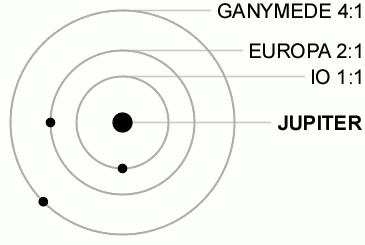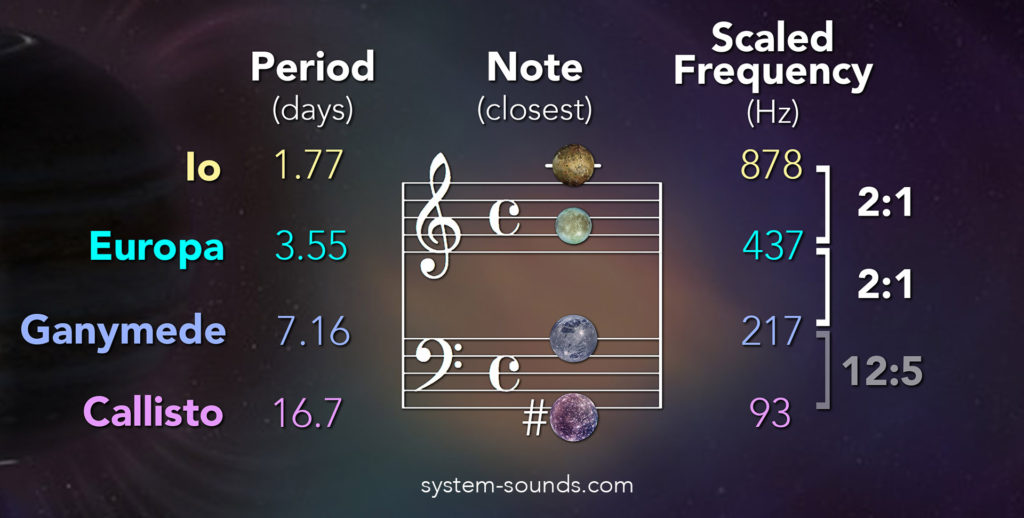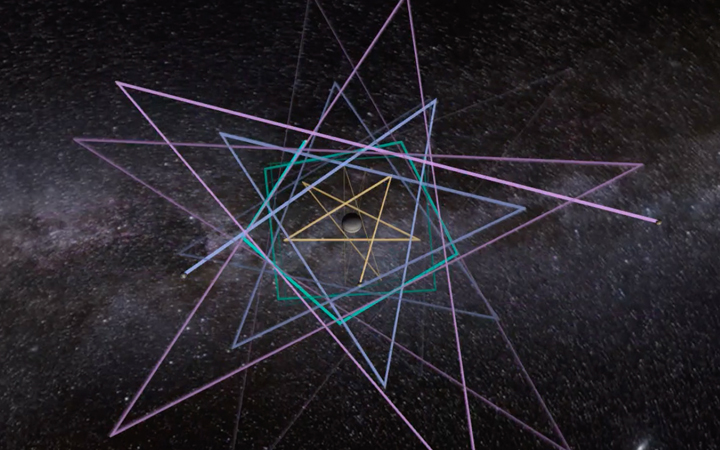Orbits of Jupiter Moons Transformed into Mind-Bending Optical Illusions and Music
Order has risen from the chaos of the creation of our solar system, and that systemization is on display through the gravitational push and pull of the bodies it harbors. A clear example of this is Jupiter and its four largest moons: When their orbital dynamics are converted into rhythms, musical notes and time-lapsed illusions, you'll likely be astounded by what you see and hear.
To understand how it works, you have to first break down the orbits.
After the three inner moons of the Jupiter system were created, they eventually settled into a simple 4:2:1 orbital resonance. In other words, it takes twice as long for Europa, Jupiter's second-closest moon, to orbit Jupiter as it does Io, the closest moon. And, in turn, the third-closest moon, Ganymede, takes four times as long as Io to orbit Jupiter. [Hear the orbits of Trappist-1 system planets turned into music]

The fourth moon, Callisto, completes the quartet of Galilean moons — which were discovered by Italian astronomer Galileo Galilei in 1610 — and it is the farthest of the bunch. It orbits at a 12:5 resonance: 12 orbits of Ganymede are equal to five orbits for Callisto. Using these statistics, Matt Russo, Andrew Santaguida and Dan Tamayo of system-sounds.com have created a musical representation of the orbits. Io, Europa and Ganymede are "playing the same note but in different octaves," when the orbits are converted into musical pitches, according to an explainer on their website — the pitches metaphor is appropriate because octaves follow a similar resonance structure; to go an octave higher, you double the frequency of the sound. In the case of Callisto, the pitch occurs at an "interval of an octave plus a minor 3rd," they wrote, since its resonance differs from that of the other moons.

The trio used the ratios of the moons' orbits, combined with an animation of Jupiter and its moons, to generate a rhythmic beat that is based on each moon's resonance, before slowly speeding it up from 30,000 to 250 million times the actual orbital speed (seen at the top of this page — turn on sound). "As [the moons] begin orbiting faster than 20 times per second (20 Hz), the repetitive beat morphs into sustained musical harmony," the explainer goes on to say — based on those octaves mentioned above.
The geometric patterns that form in the animation as it speeds up are obviously not a true representation of what the orbits look like. The patterns occur because the frame rate that the video was created with just can't keep up. The result is a stroboscopic effect, which the System Sounds website compares to a "wagon wheel" optical illusion you see when a "car wheel (is) spinning so fast that it appears to stop and start spinning backwards."
Get the Space.com Newsletter
Breaking space news, the latest updates on rocket launches, skywatching events and more!

All those factors combined turn into a mind-blowing, 70-second experience that we highly recommend you watch in full screen with a good sound system or headphones. You can even get interactive with it below — just click Play and drag NASA's Juno spacecraft to speed up the orbits; you can also turn the moons' orbits on or off by clicking on them.
To take a deeper dive into the musical details and to see some more "hypnotic" orbit animations, visit the System Sounds website.
Follow Steve Spaleta on Twitter or Facebook. Follow us @Spacedotcom, Facebook and Google+. Original article on Space.com.
Join our Space Forums to keep talking space on the latest missions, night sky and more! And if you have a news tip, correction or comment, let us know at: community@space.com.

Steve Spaleta is Space.com's Senior Producer. Since 2007, Steve has produced and edited space, science and entertainment-related videos for Space.com. He is also the producer/writer/editor of Space.com's CosMix series on space-enthused artists. He studied psychology at the State University of New York at Stony Brook and is originally from Zadar, Croatia by way of Astoria, NY. To see Steve's latest project, follow him on Twitter and follow Space.com's VideoFromSpace YouTube Channel.









